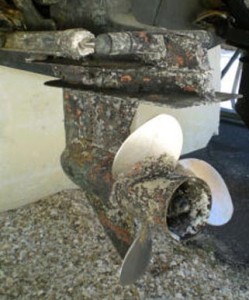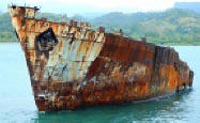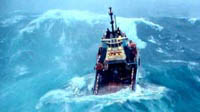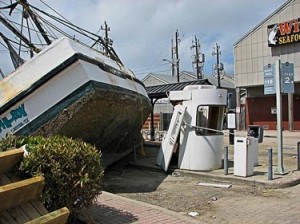The singularly most misunderstood, but frequently discussed, problem in boating is corrosion. Corrosion of metal components below the waterline will be a problem all boaters will eventually encounter and inevitably discuss with their boating neighbors. By far, the best source of information is a specialist such as a marine electrician, electrical engineer or metallurgist. Unfortunately most of them speak an incomprehensible language. Furthermore, the few specialists who are able to speak in simple, understandable terms don’t stop in time. They continue their explanations about ions, electrons and current carrying conductors until the basic explanation gets lost in the mental overload that follows. For those who wish to understand this subject in basic terms, you are in luck. The following explanation is written by an electrical simpleton and remains basic from start to finish.
Let’s begin with some very basic concepts. Alternating current (AC) is the type of electricity from the shore power cord, generator or alternator. Direct current (DC) is the type of electricity from the batteries. Circuit breakers are designed to prevent the overheating of wires and fires. Ground fault circuit interrupter devices, such as G.F.C.I. protected AC electrical outlets are designed to protect people. It is more important to protect people and prevent fires than it is to prevent corrosion. Bonding is connecting metal components with wires, resulting in electrical continuity. This is done with most below waterline metal components, including through hulls, struts, propeller shafts and rudders.

Testing for voltage and current can get complicated fast. The only testing we will discuss is electrical continuity. On virtually all electrical meters there is a continuity test, the symbol is an ohm sign (horse shoe). To determine if one metal component has continuity to another, set the tester on this setting, touch one metal with one of the tester’s leads and touch the other metal component with the other lead, continuity is indicated by a beep or a number. A number near one is good continuity. This test will allow you to determine if your rudder is continuous with a sacrificial anode or if a through hull is included in the bonding system.
It is unlikely that the cause of your corrosion problem is the “stupid wiring” at the marina. The wiring on your dock is almost certainly to an electrical code. The wiring on your boat is almost certainly not to code, as the only legal requirements apply to commercial, not recreational vessels. There is no “code” or Coast Guard requirements for the electrical system on your boat. While there are standards and recommended practices, compliance with them is voluntary. Regardless, metal corrosion in boats is a result of the laws of nature or a failure aboard the boat and rarely a result of a problem with the wiring on the dock.
The normally green AC ground wire used by the marina does provide a path for an electrical current that can contribute to corrosion. It also provides a path to ground in the event of an electrical problem and is designed to save lives. Don’t cut it! There are two common choices that can be used to allow the safety aspects of the AC ground wire and reduce or eliminate its contribution to corrosion, galvanic isolators and isolation transformers. Galvanic isolators are relatively inexpensive devices that prevent most problems associated with the AC ground wire. A more sophisticated, expensive and reliable method to prevent AC ground wire related corrosion is an isolation transformer. Without falling into the abyss of electrical theory, both devices reduce the potential for corrosion on your vessel. By using these devices and leaving the AC ground wire connected as designed, the boater can reduce or prevent corrosion while allowing the safety components to function as designed.
There are two primary types of corrosion experienced by boaters: galvanic and stray current. Galvanic corrosion is a natural process which occurs when dissimilar metals have electrical continuity and are immersed in the same electrolyte. In other words, different metals are either in contact with each other or connected by a wire and they are in the same body of water. This is by far the most common cause of corrosion. Stray current corrosion is caused by an electrical current leak and in the boater’s world is almost exclusively direct current (DC). This simply means that the primary source of the power driving this type of corrosion is your batteries not your shore power cord.
Another type of corrosion experienced mostly by high performance vessels is called cavitation corrosion or impingement. This primarily is seen on high speed propellers or rudders and is not addressed in this article. Anaerobic corrosion or oxygen starvation damage effects stainless steel where it is wet and starved of oxygen. Sailboat rigging and propeller shafts are common victims of this type of corrosion; this is also not addressed in this article. Both of these types of corrosion are unusual.
Galvanic corrosion is the common cause of corrosion on boats. The prerequisites, electrical continuity between the dissimilar metals and common water are the only things we need to understand to fight the good fight against it. If we bond all below waterline components, the least noble metal will corrode faster. While the theory is most easily understood if we use two separate pieces of metal in our examples, a single metal component can galvanically corrode. A bronze propeller is an alloy of several metallic elements, including copper and zinc. In this example, if left unprotected, the zinc will corrode out of the alloy, leaving a higher concentration of copper. This results in a pink color, versus bronze or gold. It also results in a much softer and weaker metal. Galvanic corrosion can also occur where two dissimilar alloys are in contact above the waterline, such as a steel fastener in an aluminum toe rail. In this case the aluminum will corrode. The least noble metal will lose this fight every time. This is a fundamental law of nature.
To protect against galvanic corrosion we use paint, sacrificial anodes (usually zinc), galvanic isolators or isolation transformers. The most effective form of protection is paint. If a piece of metal is completely isolated from the ocean by paint, it will not corrode. This is the initial method for protecting outdrives and outboard engines. The paint has to be designed for this purpose; anti-fouling paint is not designed to prevent corrosion. Metal boats are painted to reduce corrosion.
For a sacrificial zinc anode to protect a metal component from corrosion, it needs to have electrical conductivity and immersion in the same body of water. In other words your zinc anode must be touching or connected by a wire to the metal you are trying to protect and they both have to be on the bottom of your boat or in the same component in your engine. Simply speaking, connect all submerged metal to the zinc anode. The anode on your transom is not protecting your rudder unless your meter beeps when you touch both components. The sacrificial anode in the engine’s heat exchanger (a big round tube on the back of your engine) does not prevent corrosion in the exhaust manifolds. And, by the way, you should replace that anode in your heat exchanger.
The plate zinc on your transom rarely protects the propeller shaft and the propeller. It is difficult to maintain continuity with a propeller shaft that spins several thousand revolutions per minute. The most practical means to protect the propeller shaft and propeller from galvanic corrosion is a collar zinc installed directly on the shaft. You do not need to put a zinc anode on every piece of submerged metal. However, if you wish to provide galvanic corrosion protection, the metal does require continuity with a zinc anode located somewhere on the bottom of the boat.
By their nature, outdrives have corrosion challenges. Aluminum is low on the galvanic chart thus subject to corrosion more easily than bronze or stainless steel. Zinc anodes can reduce corrosion on an outdrive but the rubber bushings isolate the various components including the hydraulic rams, steering components and transom assemblies. Electrical continuity must be maintained between each component part and a sacrificial zinc anode in order for all parts to have protection. Small cables used for this purpose often become disconnected and the zinc anodes are more difficult to see and maintain than transom plates or propeller shaft collar zincs.
Trim tabs corrode. Deal with it.
Stray current corrosion is a much more rapid and damaging condition. The good news, it is unusual. The bad news, it is much more destructive and more difficult to diagnose. Extreme cases of stray current corrosion can result in a good propeller taking the form of Swiss Cheese in a matter of days. A through hull flange can disappear and solid steel components such as propeller shafts and rudder shafts can be severed. As previously mentioned, the root cause of this problem is a DC electrical stray current leak. An electrical short circuit has occurred and the current is being discharged into the water. One piece of metal will inevitably be coated with a white compound and another piece of metal will suffer metal loss. What the boater will experience is a sudden change in the condition of a submerged metal component, often found by a diver. The root cause will often end up being a failed electric motor, bilge pump or battery charger.
Sacrificial zinc anodes will not protect against stray current corrosion. Superman is defenseless against Kryptonite and metal is defenseless against a stray current. If a stray current problem is suspected, call a professional. The source must be eliminated. Take immediate action, boats have sunk after the through hulls were destroyed by stray current corrosion in a few days.
We do not believe that all metal components necessarily require bonding and protection with a sacrificial zinc anode. While there are standards which recommend this practice, we have seen many quality alloys last for several decades, virtually undamaged. We do believe that a bonding system should be complete if attempted, a complete bonding system or no bonding.
Fiberglass boats can not be “over zinced”, or install so much zinc that damage is caused. Wood and metal boats can be “over zinced”. This issue is particularly important to wooden boat owners. The amount of zinc installed on wooden and metal vessel is important and should be measured and maintained actively.
There are devices available to measure the amount of protection provided by zinc anodes. They are seldom understood or used as designed. If your boat has one, either learn how it works and use it actively or abandon it and use the simple system of bonding everything to a zinc.
There are more sophisticated corrosion prevention systems which are generally used in commercial applications. While zinc anodes are “passive” some outdrives and many steel ships and structures use “active” systems. Some of these systems impress a current into the water to prevent corrosion. These systems are beyond the scope of this article.
Corrosion of that toe rail we discussed earlier (and other above waterline metal) can be reduced by washing away the salts left after a day sailing. We won’t broach the subject of tank failures, just keep them dry.
Remember to protect metal with an anode; it needs electrical conductivity and a shared body of water. Sudden corrosion or significant changes in the metal components require immediate attention by a qualified expert, and follow the advice of that crusty boating neighbor at your peril.





